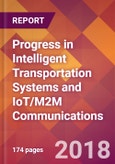This report reflects a steady movement of the Intelligent Transportation Systems (ITS) towards reaching their goal – minimizing roads accidents and traffic jams. In connection with this goal, the report provides details of the ITS structure and architecture; and emphasizes contributions of wireless technologies designed for IoT/M2M – this type of communications is becoming very important for ITS to enhance their characteristics. In 2015, the IoT has already disrupted the 4G roadmap and become a prime driver of the 5G specification process.
The following recent (or still in the development) wireless communications standards are addressed:
- LoRa
- LTE-M
- 802.11ah
- EC-GSM
- SigFox
- Weightless Protocols
- Other.
These technologies are being developed with considerations of IoT/M2M communications specifics.
The report also addresses the current status of IoT/M2M and ITS industries, their markets and surveys vendors’ portfolios.
The significant part of this report addresses the introduction of a driverless car – IoT/M2M communication supports all major functionalities of such a car. Details of a young industry development, its major players, the standardization process, hurdles and enablers are analyzed. The report emphasizes the driverless car benefits – they, as it is envisioned currently, will be realized in the 2035-2040 time frame; with these cars on roads already in 2018-2020. The industry identified driverless cars as most viable form of ITS, dominating the roadways by 2040 and sparking dramatic changes in vehicular travel and the auto industry.
The report also surveys 802.11ah-related patents (2017-2018).
The report is written for a wide audience of technical and managerial staff involved in the advanced ITS development; and for specialists in communications technologies that support such a development; particular IoT/M2M communications.
Table of Contents
Companies Mentioned
- AdaptIVe Consortium
- Adeunis RF
- Aeris
- Airbiquity
- Alphabet
- Altair
- AT&T
- Audi
- Autotalks
- Axeda
- B3IT
- Baidu
- BMW
- Cohda Wireless
- Continental Automotive
- Continental/HERE
- Cruise Automotive
- Daimler/Mercedes
- Danlaw
- Ford
- Gemalto
- GM
- Honda
- Huawei
- IMS
- Induct Technologies
- Innocomm
- Intel
- Jasper Wireless
- Kore Telematics
- Libelium
- Link-Labs
- Lyft
- Microchip
- Mistbase
- Nissan
- Nordic Semiconductor
- Numerex
- Nvidia
- On Semiconductor
- QNX
- Qualcomm
- Qualcomm Technology
- Raco Wireless
- Samsung
- Sequans
- Sony Group
- Swisscom
- Telit
- Tesla Motors
- TI
- U-blox
- Uber
- Volvo Cars
- VW
- Waymo
- Wireless Logic
- Xirgo
Methodology
Considerable research was done using the Internet. Information from various Web sites was studied and analyzed; evaluation of publicly available marketing and technical publications was conducted.
Telephone conversations and interviews were held with industry analysts, technical experts and executives. In addition to these interviews and primary research, secondary sources were used to develop a more complete mosaic of the market landscape, including industry and trade publications, conferences and seminars.
The overriding objective throughout the work has been to provide valid and relevant information. This has led to a continual review and update of the information content.

LOADING...








